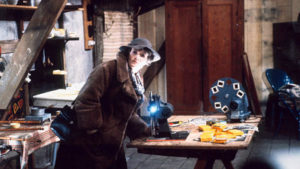STUDIO: Criterion | DIRECTOR: Alain Resnais | CAST: Delphine Seyrig, Jean-Pierre Kerien, Nita Klein, Jean-Baptiste Thierree
RELEASE DATE: 7/19/16 | PRICE: DVD $29.95, Blu-ray $39.95
BONUSES: Vintage interviews with Delphine Seyrig and the film’s composer; interview with film scholar Francois Thomas; segment from Resnais documentary; essay by scholar James Quandt
SPECS: NR | 116 min. | Drama | 1.66:1 widescreen | mono | French with English subtitles
Muriel, or The Time of Return is “a film blown to bits,” declares author Gaston Bounoure in a supplement found in this two-disc Criterion edition of Alain Resnais’ 1963 abstract classic. “Everything’s out of place, out of synch, sound precedes image. It’s [set in] a chaotic world in which people try to find each other.”
That statement best describes the imaginatively circuitous way that Resnais and his first-time scripter, novelist Jean Cayrol, formulated their unique approach to storytelling. At times Muriel plays like a romance, a family melodrama and a mystery; it would in fact fit comfortably in all three of those genres and yet strictly adheres to none of them.
At a time when many European filmmakers were offering alternatives to the conventional mode of Hollywood filmmaking, Resnais was perhaps the most rigorous and challenging of the New Wave stylists. As a result, Muriel is a film that remains very distinctly modernist more than a half-century after it was released.
The plot is a family affair centering around an antiques dealer (Delphine Seyrig) and her stepson (Jean-Baptiste Thierree). The stepson is haunted by his experiences in the Algerian War (where the titular Muriel was a civilian he and other soldiers tortured); his stepmother is confused by the arrival of an ex-lover (Jean-Pierre Kerien) with whom she had a doomed affair during the World War II.
Muriel is an experiment in abstraction that has solid political underpinnings, concerning two of the biggest events in 20th-century French history. According to the supplements included here, Resnais worked for several years with Cayrol on the script and took an active part in fragmenting the narrative into hundreds of separate images, all the better to depict characters who are confused about the past, misremember events and at points blatantly lie to each other.
Resnais thus makes the familiar unfamiliar, as everyday events are broken down into several dozen close-ups, and characters’ glances often do not “connect” with the characters they’re speaking to. The film is very jarring, but also — in a manner different from his preceding existential “mystery” Last Year at Marienbad — draws viewers in even as it takes steps to alienate their perception of what is happening.
As could be imagined, the supplements included here are invaluable in terms of both piecing together the fragmented narrative and also understanding Resnais and Cayrol’s more radical gestures, like introducing new characters near the end of the film and having a pivotal angry speech intercut with static shots of apartment buildings.
In addition to a segment from the 1980 documentary Une approache d’Alain Resnais in which Cayrol is interviewed and Bounoure makes the “blown to bits” quote, there’s a very enlightening new interview with film scholar Francois Thomas, who analyzes the film in detail. He discusses how Cayrol came to write Muriel for Resnais after supplying the commentary for Resnais’s classic doc Night and Fog (Cayrol was a French Resistance fighter who was imprisoned in a concentration camp).
Thomas also maintains that the film is not just a marvel of editing but also of scripting, since each of the several hundred shots in the film was indeed in the final script developed by Cayrol and Resnais. He also emphasizes the fact that French viewers in 1963 would have better understood the film’s references to the Algerian War. (The war was over by ’63, but previous films, like Godard’s Petit Soldat, were banned by the French government for tackling the topic).
Also important is Thomas’s discussion of the setting, the town of Boulogne, which had been heavily bombed in WWII. By the early Sixties it had become “two cities” — one that had modern apartment houses (the buildings seen in the static shots that punctuate the angry speech near the end of the film) and another that still showed the devastation wrought by the war.
Two vintage TV interviews find Seyrig and composer Hans Werner Henze talking about the film. Seyrig’s interview is fascinating, in that she stresses Resnais made Muriel to contrast with Marienbad. He chose to vary the visual style and editing, cast her as a non-sexy older woman (after her sultry, elegant look in the earlier film) and had the cast “do concrete things” on-camera, as opposed to Marienbad, where Seyrig notes that she had to walk a lot. Quite a lot in fact — one gets the distinct impression she preferred the “concrete” actions.
|
Buy or Rent Muriel, or The Time of Return
|
|||
|---|---|---|---|
 |
|||

Leave a Reply